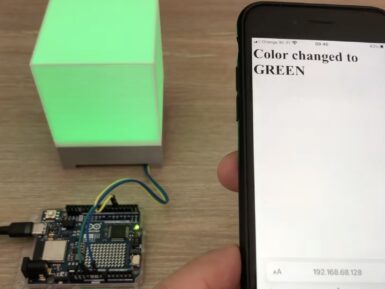
Overview
This sensor SharpGP2Y0A21YK, boasts a small package and very low current consumption, takes a continuous distance reading and returns a corresponding analog voltage with a range of 10cm (4") to 80cm (30"). It can be used in TVs, personal computers, cars and so on.
Features:
- Grove interface compatible
- Wide supply voltage range: 2.5V-7V
Interface:
The sensor is quite small and use a tiny connector called a JST connector. These connectors have three wires: ground, vcc, and the output. Because the sensor fires continuously and don't need any clocking to initiate a reading, it is easy to interface with any microcontroller.
Tech specs
Technical Details
|
Weight |
G.W 8g |
Part List
|
Grove - 80cm Infrared Proximity Sensor |
1 |
|
Grove Cable |
1 |
Get Inspired

Syntaxx is powered by three Arduino boards, each handling specific functions to create a seamless and dynamic performance:

It can be tough to get started with building an Internet of Things (IoT) project from the ground-up, as getting connected, serving a webpage, and managing other devices can all be a challenge to a beginner. This is why the YouTuber known as “Mario’s Ideas” made an end-to-end tutorial that details everything one might need to build a smart RGB lamp. Because the Arduino UNO R4 WiFi contains an ESP32-S3 chip for its Wi-Fi radio and Renesas RA4M1 microcontroller, it was the perfect candidate. Mario’s sketch begins with a call to initialize the Wi-Fi module before attempting to connect to his local access point. Once finished, it enters a loop that continuously checks if a client has connected to the web server, and if one has, reads the requested path while also seeing if the string contains “/H” to denote an “ON” command to set the LED. Toggling an LED is useful, but Mario wanted to take things a step further by building a tangible — in this case a lamp. His 3D-printed enclosure features a recessed base and translucent cube for diffusing the light emitted by a grid of NeoPixels. Controlling the color was just as easy since any browser could still send a request path containing a color and get back the lamp’s updated status. To see more about this IoT lamp project, you can watch Mario’s video below!





